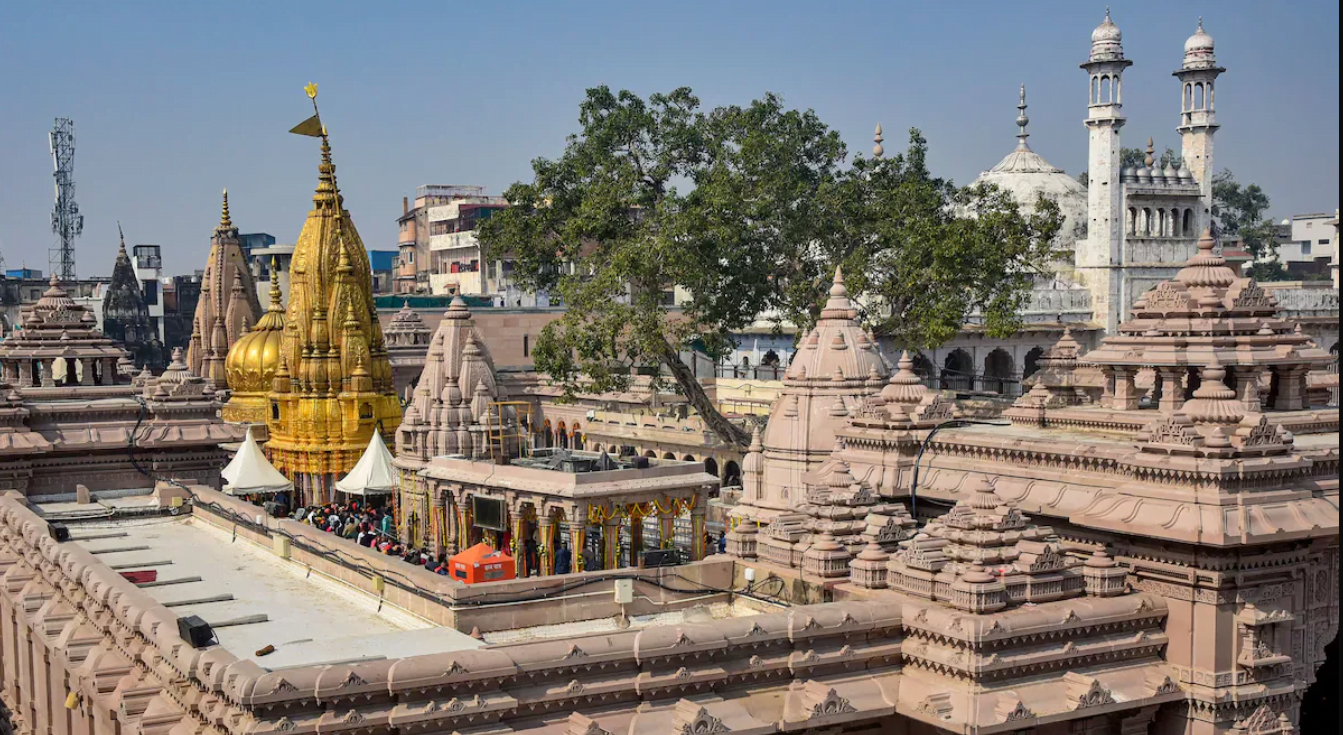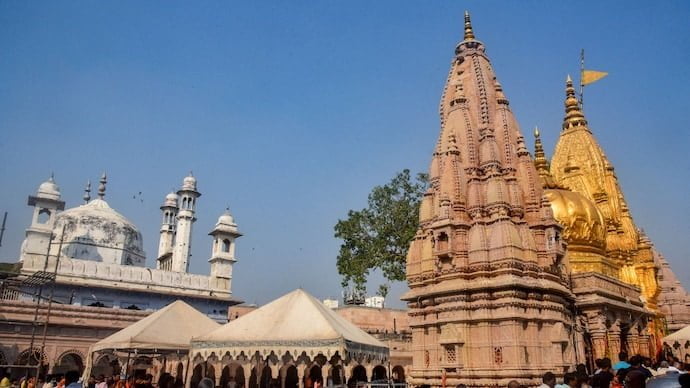Last week, a Varanasi District Court allowed Hindu prayers to be conducted in the basement of the Gyanvapi Mosque complex. A court-ordered Archaeological Survey of India report that was recently made available found that a ‘large Hindu temple’ existed where the mosque currently stands, prior to its construction in the seventeenth century under Aurangzeb’s reign.
The Gyanvapi dispute, much like the Babri Masjid one, dates back several decades, with the first suit in the case filed in 1991.
This comes at the heels of the inauguration of a temple at the disputed site of the Babri Masjid in Ayodhya; with the Gyanvapi dispute drawing undeniable parallels to the Babri Masjid dispute. The Gyanvapi dispute, much like the Babri Masjid one, dates back several decades, with the first suit in the case filed in 1991. Gyanvapi is one of three places of worship (the other two being the Babri Masjid in Ayodhya and the Shahi Idgah in Mathura, all three of which are in Uttar Pradesh) that Hindutva groups stake claim to on the basis that Hindu structures once existed beneath them, which were destroyed during Mughal reign.
The Gyanvapi dispute and The Places of Worship Act, 1991
The Places of Worship (Special Provisions) Act of 1991 guarantees the preservation of the religious character of places of worship as they existed upon India gaining independence on August 15, 1947. The Act was passed in the wake of the Advani-led Rath Yatra in 1990 for the construction of a temple in Ayodhya. While this 1991 provision should seemingly settle the matter and answer any questions concerning the Gyanvapi dispute, the issue doesn’t seem to be as straightforward.
The Allahabad High Court, rejecting a plea filed by the Anjuman Intezamia Masjid Committee and Uttar Pradesh Sunni Central Waqf Board arguing that the five suits filed by Hindu worshippers be dismissed on the basis of the 1991 Act, claimed that while the provision protects places of worship from their religious character being altered as it was in August 1947, the question in the Gyanvapi dispute remains as to what the religious character of the place is. According to The Wire, Justice Agarwal of the Allahabad High Court said in his judgement, ‘It is the Court who has to find out from the facts and circumstances of each case as to the religious character of place of worship.’
The Gyanvapi dispute and the saffronisation of history
Beyond legal questions pertaining to the religious character of the disputed site and with which party the rightful claim to the site lies, the Gyanvapi Mosque dispute brings up troubling questions about the extent to which Hindutva narratives permeate popular sentiment and the threat this poses to Indian pluralism and the secular nature of the Indian state.
Undoubtedly, this is not merely a religious issue, it’s marred in politics. Attempts to claim Islamic places of worship for Hindu use are a flagrant attempt at distorting India’s history. The Hindutva ideology has a contentious relationship with India’s Mughal past and increasingly the response to this irreconcilable discord between the Hindutva persuasion and India’s past realities is to re-write Indian history in a way that distorts facts to make the past more palatable to those on the Right and fit their narrative.
In 2023, the National Council of Educational Research and Training (NCERT) deleted chapters about Mughal history (among other things) from their textbooks. The realities of the multicultural tapestry of Indian society threatens the Hindutva idea of an India possessing a monolithic Hindu character and their attempts to reframe India’s culture as exclusively Hindu, with all influences from other religions that long existed in the sub-continent being deemed as foreign. The rewriting of history in a way that treads the Hindutva line serves to rob an entire generation of Indians of much-needed context to understand the centuries-long syncretism that has been a constitutive part of the modern, secular Indian state and was – at least to some degree – a prominent feature of Indian society for a very long time.
Aurangzeb’s motive to destroy around a dozen temples during his reign is often understood to be political in nature by historians, far from the attempt to persecute Hindus that many today claim it to be. But Aurangzeb’s motives notwithstanding, the simple fact remains that staking claim to Muslim places of worship based on what once existed there is a dangerous precedent to set and erodes the secular fabric of a country that enshrines the freedom of religion in its Constitution. Further, when elected representatives champion these causes and legitimise these claims by lending them their support – whether it be for political or religious reasons – this blurs the line between state and religion, which no secular democracy can afford.
The August 15, 1947 cut-off that the Places of Worship (Special Provisions) Act mandates is prudent. The argument that preserving the character of religious places of worship as it was on the day that India came into existence as an independent state has merit. What India was on that day was a sum of all its history and a product of the subcontinent’s plurality. Some question the 1947 cut-off, with some MPs recently arguing that the real cut-off should be the twelfth century. But this is an arbitrary line in the sand. Further, allowing for the restoration of places of worship to their religious character as in the twelfth century is fundamentally an attempt to paint over Muslim elements of India’s history with a saffron brush.
Far-right agenda
Staking claim to centuries-old mosques is essentially a re-writing of India’s history to fit the Hindutva agenda. Hindutva’s inability to reconcile with India’s Mughal past and whatever remains of present-day syncretism, unfortunately, is informing and shaping popular sentiment. Disinformation and misinformation are rife in India. The internet is a haven for half-truths and blatant lies that re-frame both history and the present based on ideological whims and idiosyncrasies. And this phenomenon is slowly but steadily permeating popular discourse, culture, and even academia. This is troubling, to say the least.
Hindutva’s inability to reconcile with India’s Mughal past and whatever remains of present-day syncretism, unfortunately, is informing and shaping popular sentiment.
India, for the longest time, boasted of its plurality: of religion, culture, language, and tradition. But with significant political shifts to the right in the last decade, popular sentiment has started to go the Hindutva way. It is wholly unbecoming of a country and a people who have a centuries-long tradition of syncretism to strive to create a monolithic Indian identity that is only Hindu in nature.
History cannot be subject to ideological whims. It’s not for us to rewrite history in an effort to make it more palatable to popular sentiment. An institutional and popular shift to the far-right affords impunity to those engaging in blatant Islamophobia, in words and in action. Staking claim to Muslim places of worship threatens to dilute the guarantee of the freedom of religion enshrined in the Constitution. This re-writing of history to paint a picture of India’s past where Hindus enjoyed a single Hindu identity and a monolithic culture until the Mughals attacked this homogeneity might be in line with Hindutva convictions, but the fact remains that this is far from the truth. Whatever one’s opinions of the Mughals or their reign, assuredly they remain an integral part of India’s past and the remnants of that time in Indian history should not be erased.
At a time when the Hindutva tide is washing over India, these claims to Muslim places of worship aid the Hindutva goal of reframing India’s past and present through an us vs them lens to solidify the lie of a long-standing threat to Hindu identity that continues to this day. Erasing historical and cultural remnants of India’s centuries-long Islamic rule robs us of precious historical context to make sense of and attempt to carry forward the syncretism that has long been an integral part of India. The saffronisation of the past will render history a mere tool to further an ideological agenda. We must retain history as a whole; we cannot allow for parts of it to be retained while the rest is written over.
About the author(s)







